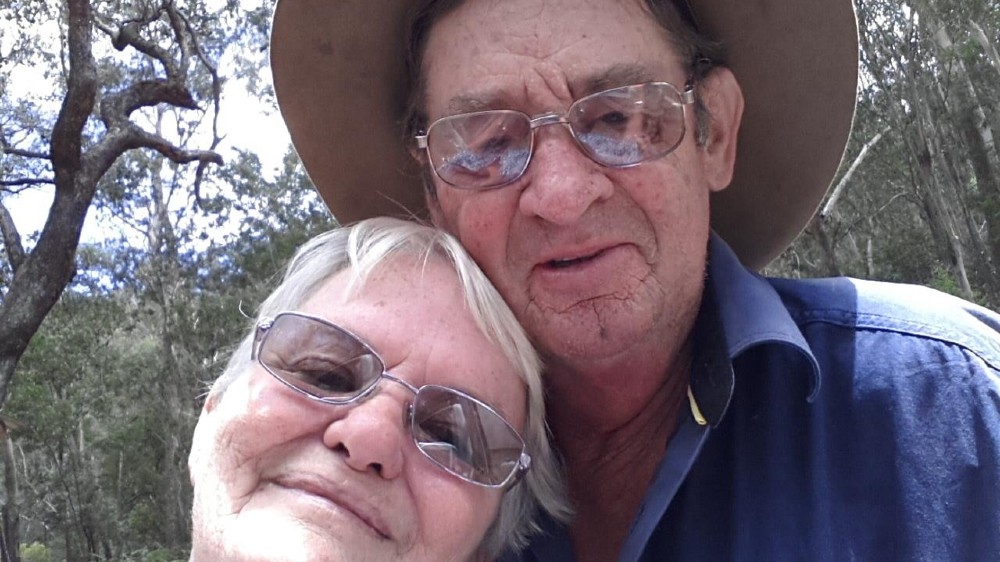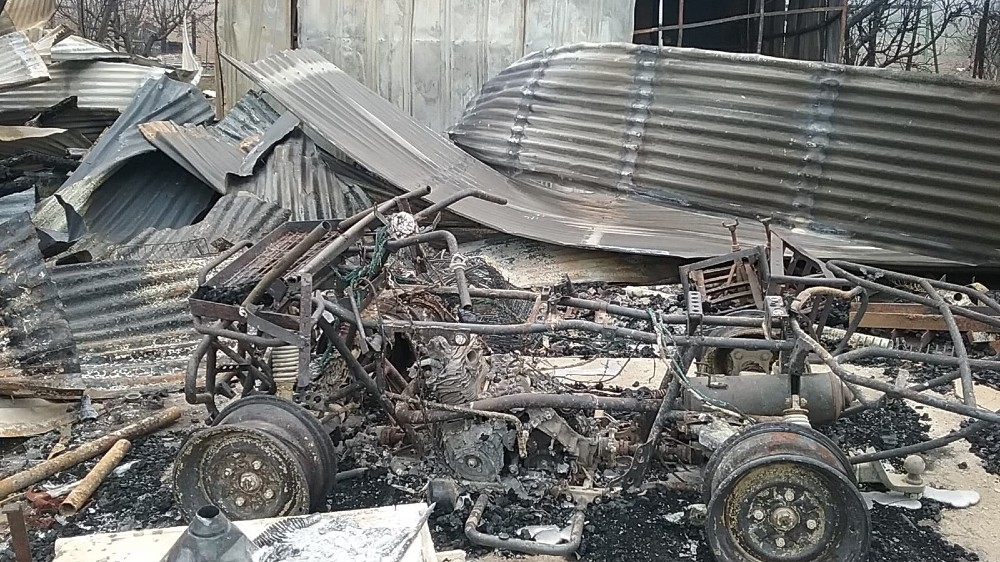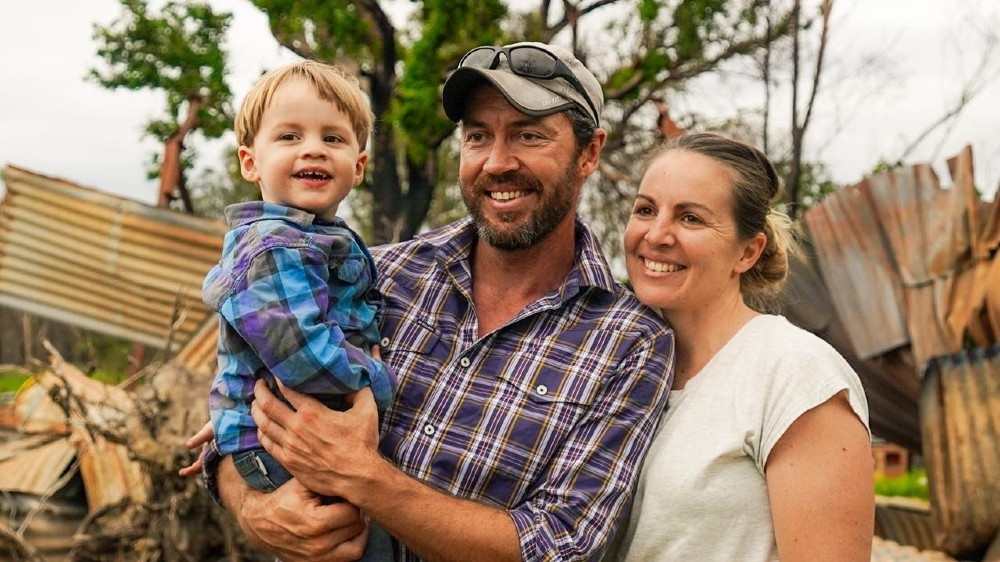
'Why are we still struggling?' ask Australia bushfire victims
People who lost nearly everything as fires tore through vast tracts of Australia say they are still waiting for help.
by Zoe OsborneWhen the Australian bush went up in flames over the southern hemisphere summer, the world pulled together in support.
The Australian government established a two billion Australian dollar ($1.3bn) fund to assist fire-affected communities and wildlife.
More:
But now, several months down the line, as a royal commission this week began its investigation into what happened, many communities are little further forward than they were back then. People are still living in tents, waiting on loans, unable to rebuild their lives.
The fires ravaged Gloria Sutherland's property in Yowrie, in southern New South Wales, at three in the morning, sweeping into the valley from the ridges above and into her back paddock. Nearby towns were hit too.
"It just had no mercy for anybody," she said.
Sutherland recalls fireballs the size of her hand and bigger being spat out by the blaze as it raced towards her home.
"Where the fire went into our laundry it broke a window," Sutherland said. "The fire actually smashed a pane of glass … the balls [were] like rocks being thrown."
No one came to help the 63-year-old and her husband, Peter, 67, not even the fire brigade, because they were so far out of town. It was "just the two of us, two old people", she remembers.
They defended their house until they ran out of water and then retreated inside, with nothing left but hope.
Come together
As pictures emerged of the scale of the devastation, money poured in for those affected. Hundreds of millions of dollars were raised for bushfire relief across the country.

The fire 'had no mercy for anybody' Gloria Sutherland told Al Jazeera. She and her husband battled the blaze alone when it swept down onto their property [Supplied/Al Jazeera]
Among other charities, the Australian Red Cross raised 216 million Australian dollars ($142.8m), the Salvation Army 41 million Australian dollars ($27.1m) and the St Vincent de Paul Society 22.9 million Australian dollars ($15.1m).
A number of celebrities, sportspeople and businesses joined the cause too.
In January, the Australian government announced its package for bushfire recovery, covering a range of initiatives such as mental health, local tourism, and grants for bushfire-affected farmers.
But in bushfire-hit communities, people say they have little to show for it.
Dan Tarasenko lives in Quaama in southern New South Wales, one of the areas that was worst-hit by the fires.
"I have a house, not much else," Tarasenko told Al Jazeera.
Half of his sheds are gone, half his livestock and all of his fences. Just about everything is damaged to some degree.
He says that the government has been slow to deliver support.
Tarasenko applied for two government loans but on Monday - after a 13-week wait - was told that one of his applications had been rejected. The other was rejected on Tuesday after seven weeks of waiting.
Even if his loans had been approved he would still have had to wait for the funds to come through.
"[They] come in after the fact so we're looking at six, eight months of lost income," he said.
Without the loans he applied for, Tarasenko has no way to restart his business because only government loans allow farmers to use the money to replace livestock.
He is appealing but has no idea how long the process could take.
"I'm fighting publicly," he told Al Jazeera, saying he had highlighted his case to local politicians. "We are giving evidence to the royal commission on Thursday. What else can we do but keep fighting."
Many other fire-affected communities are facing similar struggles.
"[The government] want[s] financials, they want security, they want details … I can understand it but it is turning people away," Tarasenko said. "and then delays, [people think] ... why bother?"
Charities have also come in for criticism amid accusations that they have only delivered a small proportion of what they raised.
As of the first week of May, the Australian Red Cross had used 40 percent of the money it had received since January, and The Salvation Army had spent 46 percent. The two are among Australia's biggest civil society groups and received a large share of the funding.
The St Vincent de Paul Society, which was one of the first on the ground in the aftermath of the devastation, has spent more than 13.5 million Australian dollars ($8.9m) - 59 percent of its donations.
The Red Cross says delays have been because of the large numbers of fraudulent applications they received, but also because they want to focus attention on long term recovery.
"Typically … for people to really get back to functioning in what we might call a "new normal" will take… anywhere up to … five to 10 years," said Andrew Coghlan, Head of Emergencies for the Australian Red Cross.
"We've allocated a small portion of the funds to be able to run our recovery programme … and we'll have people out on the ground for the next three years."
There has also been speculation that charities have used the donations they received for administrative costs or initiatives other than the fires.

The fire tore through the Sutherland's property reducing buildings and vehicles to charred wrecks [Supplied/Al Jazeera]
The Australian Red Cross, Salvation Army and the St Vincent de Paul Society all told Al Jazeera that this was not the case and that all their funds are being used for bushfire recovery.
The physical clean-up has also been slower than expected. Part of the problem is COVID-19 - leaving the government overwhelmed under the weight of two crises at once.
In a recent news conference, Prime Minister Scott Morrison assured Australia that throughout the COVID-19 crisis, the National Bushfire Recovery Agency and other agencies had been "working on the ground to deliver the supports that we said would be there" in response to the bushfires as well as floods and drought.
Earlier this month, the government released more money for recovery, mental health support, the development of telecommunications, forest management, and wildlife habitats.
Morrison said South Australia's clean-up was almost complete, and he expected NSW to be finished by the end of June and Victoria "sometime in August".
Official inquiries
The Royal Commission into National Natural Disaster Arrangements - an inquiry into how Australia can prevent devastation from crises like the bushfires in the future and how we can help communities recover now - began its hearings this week, with a final report expected by the end of August.
Another investigation, the NSW Bushfire Inquiry, will deliver a report by July 31.

Dan Tarasenko with his family. This week, after months of waiting, he learned that his applications for two key loans to help him rebuild had been rejected [TBH Media/Al Jazeera]
But preparing for the next fire season is arguably just as important as moving recovery forward.
For Tarasenko, forest management is the key issue.
"You can't have an overgrown forest that … loves fire," he said.
Tarasenko argues that modern society has destroyed many of the factors that are essential to Australia's forests.
"We have sent many animals extinct, and removed Indigenous input, and [we] scratch our heads whilst it incinerates," he said.
The Sutherlands lost everything but their house to the fires.
Almost all of their cattle died and many of their sheep. Their sheds and fencing were left in charred ruins.
The saddest part was losing their prized bull - they only found its remains weeks after the blaze.
For now, the couple is struggling forward alone and Tarasenko is simply waiting, hoping for assistance after months of limbo.
For communities like theirs, progress cannot come soon enough.